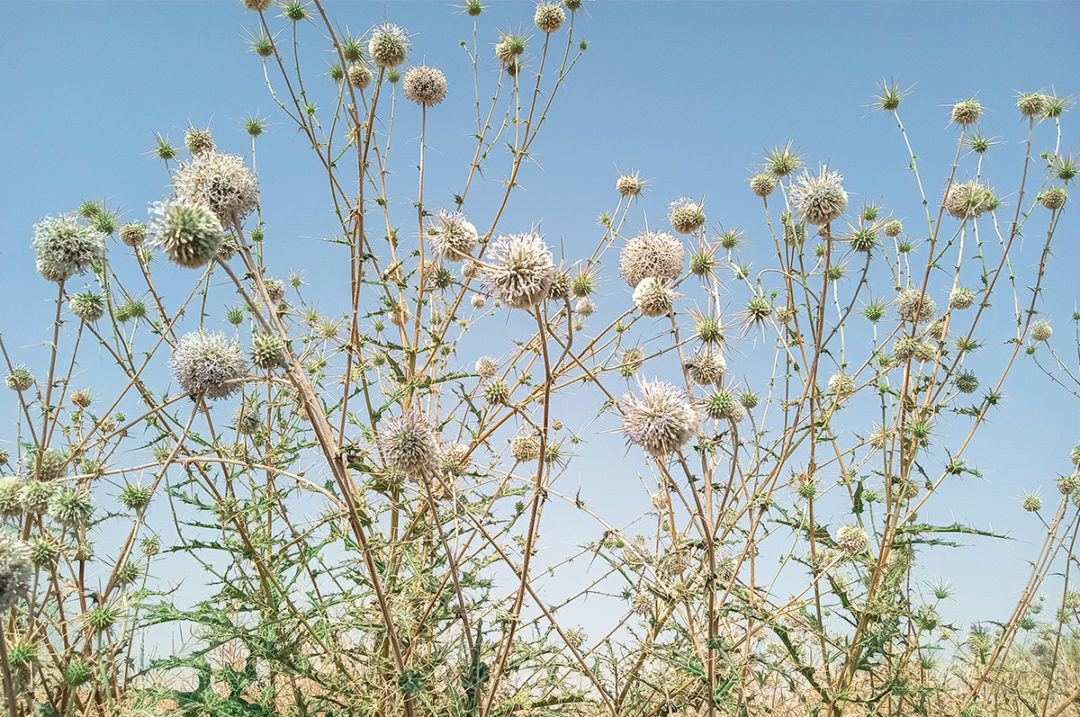From Hawaii to Puerto Rico to Alaska and throughout the U.S., hay shortages are driving the long-distance transport of baled forages across the continent and beyond. Weed seeds, stems and leaves unfortunately may be hitching along for the ride.
Remember, livestock feed can be anything that supplies energy (seeds), fiber (stems) and quality (leaf maturity, palatability). While undesirable for purity and "invasiveness," even if unpalatable, many of the common and troublesome weeds that detract from quality can provide more than 6% crude protein and more than 50% total digestible nutrients (TDN) toward an animal’s daily intake needs. They can also provide trace amounts of minerals. Keep in mind that the stage of weed maturity is a key factor in determining feed value. The presence of weed stems, leaves and seeds in feed stocks cautions the user to read up on weed identification. If weedy hay is available, take into account environmental factors that can make weeds more or less digestible, or more or less toxic, including luxury uptake of trace minerals.
The Weed Science Society of America annually surveys weed professionals for common and troublesome weeds in various crops. In the 2019 study titled "2019 survey of the most common and troublesome weeds in broadleaf crops, fruits and vegetables in the United States and Canada,” the focus included pastures, rangeland and other hay. The 2020 survey titled "2020 survey of the most common and troublesome weeds in grass crops, pasture and turf in the United States and Canada" included alfalfa.
Taking a look back at these surveys, here are some weeds from the regions that had sufficient rainfall this season. Protein ranges are reflective of the stages of maturity.
Edible and nutritious ‘weeds’ even if undesirable and crop-quality detracting
- Alsike clover: Prevalent in alfalfa in New York state, it has up to 22% protein value in vegetative stage. For horse producers, this particular clover can cause liver problems in horses.
- Arrowleaf sida: Prevalent in forage crops in Florida, it has approximately a 16% protein value.
- Broadleaf plantain: Prevalent throughout forage harvesting regions, it is a high vitamin source.
- Chicory: With a 10%-32% protein value, soil fertility and plant maturity influence protein quality.
- Knapweed and starthistle: They have a 13%-20% protein value. Some species have a spine.
- Non-spiny pigweed: As high in protein as alfalfa, pigweed are known to luxury accumulate nitrates, which will persist even in dried hay. Any hay or row crop fodder with significant amounts of pigweed should be tested for nitrate levels to determine safe feeding amounts.
- Narrowleaf hawksbeard: These yellow-flowered weeds can be quite high in protein value (30%). They are prevalent in Florida and other Southern states.
- Rushes and sedges: They have a 6%-10% protein value and are a source of fiber.
- Spiny pigweed: Spiny pigweed can irritate or even injure the tongues and gums of livestock. They are in the same category as other pigweeds for nutritional value but can have high nitrate accumulation.
- Johnsongrass and shattercane: These grasses are quite common and have nutritional value and 10%-14% protein. As with pigweeds, they can accumulate significant amounts of nitrates.
Non-poisonous oddities that may be in bales
- Carpetweed, catchweed bedstraw, cleavers: These are sticky plants in the gallium genus with annoying little seeds that entangle in hide, hair and wool. They are very common in Northeastern mixed grass hay and the feed value of the hay species outweighs the nuisance factor.
- Common ragweed: If present in hay when mature, the pollen is highly irritating. Its quality is similar to pigweed based on maturity.
- Common burdock: It is a nuisance if present.
- Foxtails: The seedhead awns are prickly like awned wheat and can cause noticeable mouth injury. They are usually associated with mixed stands of many grass species and have feed value.
The more toxic or injurious as percent of the total dietary intake – still edible
- Milkweeds and dogbanes: The latex-like sap in these plants can cause digestive disorders if too much of the weeds are ingested at one time but they are a good source of fiber and vitamins. Do a bale-by-bale evaluation as these weeds are patchy in their emergence pattern.
- Multiflora rose, autumn olive, Japanese barberry: These are common weedy shrubs with spines that grow in Northeastern states and are most likely found in mixed hay, Conservation Reserve Program ground and other fallow areas baled for emergency feed.
- Spiny thistles: Thistles are a broad group of some hundred-plus plants. The longer the spines, the more likely mouth injuries could occur. It is rather a commonly widespread weed genus, unfortunately.
Toxic weeds, residues, mycotoxins – be on the watch for
- Bouncing bet: It is reported as a common weed found in alfalfa in some areas of New York. Seeds, and to some extent the rest of the plant, contain a high amount of saponins. Most animals will refuse to eat bouncing bet. This is one weed producers should learn to recognize in dried hay.
- Curly dock: Rumex species can be an issue for sheep and goat producers. Rumex species contain oxalates, which can lead to oxalate toxicosis. It is becoming more and more noticeable in hayfields.
- Carrot family: It is common and widespread in northeastern states like Pennsylvania and New York. All members of the carrot family, whether yellow-flowered (wild parsley), or white (chervil, Queen Anne’s lace, giant hogweed, cow parsnip, yarrow), have some degree of phytophototoxic sap in the leaves, stems and seeds, which can cause burns when exposed to sunlight. Animals with white pigmentation (less melatonin) hide hair are more prone to severe sunburn.
- Horsenettle and ground cherry: These are quite common in the Northeast. In addition to spines, these weeds, notably the seeds, have toxins that can kill livestock if consumed in significant quantities.
- Jimsonweed: Datura species are becoming more common in mature corn and soybean fields in the North and South regions and pose a toxin risk in baled stubble. A spiny plant, most animals will not eat datura.
- Toxic tree leaves and seeds: Cherry seedlings are a common occurrence along field edges. Any evidence of tree leaves in a bale should prompt due diligence to rule out cherry, walnut, red maple and yews.
- Natural flora grassy meadow contaminants: Many pollinator-friendly plantings are toxic to livestock. Lupines in particular are becoming a common sight in "meadow"-grass dominant fields in the Northeast where they were purposefully planted. Natural meadows are likely to have white snakeroot and ironweed. Borages are another species that are liver toxic to horses that can be found spreading from a long-ago perennial flowerbed. Daylily toxins are also a concern. Anywhere public utilities crisscross or fracking occurs, be on the lookout for the metal sticks of surveyor flags. There is currently no requirement nationally for flaggers to use digestible flag materials to protect livestock from hardware disease.
- Ergots, molds and mycotoxins: Many grass species, whether they are improved-introduced species or naturally occurring, are a source of protein, fiber and energy at maturity (seedheads). Many of these families are also prone to colonize ergots and associated toxins in the seedhead. Musty hay or clouds of visible "dust" are caution signs for mycotoxins. For more information, see the article from last season.
As you forage ahead looking for suitable feed stocks for the next six months, balancing the ration to meet the animal’s basic nutritional needs is the goal to weather a crisis. If weedy feed is the only choice, segregating animals into their nutritional baseline groups can help maximize available feed and reduce risk from exposure to potentially toxic or injurious plant parts.
Sources around the U.S. on possible hay shortages due to weather
Sept. 26
“Hay Shortage in Puerto Rico Due to Hurricane Fiona” —BloodHorse
Aug. 15
“Drought isn’t just a Western U.S. problem. A severe shortage has hit the Northeast, too” —Los Angeles Times
“Farmers face difficult decisions amidst high hay prices, shortages” —Alaska’s News Source
Aug. 8, 9,10
“Report: Drought Impacts on Livestock Industry Explained” —Farm Bureau Arkansas
“Poor hay crop requires a sustainable winter plan” —Oklahoma State University Extension
“Maine livestock producers could face hay shortage this winter due to drought” —Maine Public Radio
July
“Big Island farmers worried about a hay shortage in Hawaii” —KITV4 Island News
June
“Texas hay season looks bleak” —AgriLife Today, Texas Crop and Weather Report
“'We can't catch a break': Montana ranchers face another year of tight hay supply” —Bozeman Daily Chronicle









